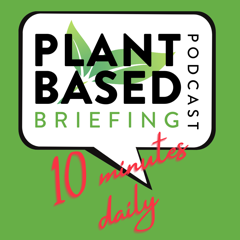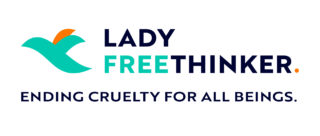Welcome to the Hope for the Animals Podcast, sponsored by United Poultry Concerns. I’m your host, Hope Bohanec. And you can find all our past episodes by going to our website, HopefortheAnimalsPodcast .org.
This is the seventh installment in a series we are calling the Reason for Vegan Series where I expose the truth about a specific aspect of the animal agriculture industry and answer the question of why we are vegan. In this podcast, I’m going to talk about goat dairy, goat yogurt, sheep cheese, and all the new non-cow animal dairy, namely goats and sheep that are farmed for their milk.
So I really love goats. Goats are awesome. I especially love the ones that have a long beard under their chin. Both males and females can have beards. And I love how they can climb on these impossibly unstable things, and then kind of comfortably levitate about 10 feet off the ground. They’re just amazing creatures.
There are over 300 distinct breeds of goats and they are one of the first animals that was ever domesticated. Different breeds range in size, there are tiny pygmy goats that are about the size of a medium dog, and there are much, much larger goats that are the size of a small cow, but most fall somewhere in between these two dimensions. Interestingly, their little ones were the original “kids.” Goat babies have been called kids for centuries, but it was only in about the 1800s that human children started to be called kids.
And they really are like kids! They love to climb, they love to play, they can be very social. And goats and sheep are so social and playful, sanctuary people have told me that they can be the most playful of all the farmed animals. They play with each other, with other species of animals, they play with humans, with visitors. They just love to play.
So I had a conversation with a vegetarian last year who said that she was aware of the cruelty in the production of cow’s milk, so she only bought goat yogurt. She believed that goat dairy products would be less cruel and offer a better life for the animals. Well, I have looked into this, and I’ve done research on the goat dairies in my area of Northern California, and what I discovered was really disheartening. And the truth is not at all the story that these companies are telling my vegetarian friend.
The popularity of goat dairy is really on the rise, particularly because people are becoming aware of the miserable conditions dairy cows endure. And if you haven’t already, I want to encourage you to listen to the Reason for Vegan Series 6: Conventional and “Humane” Cow Dairy Exposed. Because these two industries are practically identical, I don’t want to repeat too much of what I said there, so please listen to that one first and understand that most everything that you are hearing about cow dairy, applies to goat and sheep dairy as well. Just to summarize briefly, the cow dairy industry routinely drags newborn babies away from their mothers, causing extreme distress for both the parent and offspring. There’s intensive confinement, filthy conditions, sickness, pain, and abuse. These are the norm. And when her milk yield declines in just a few years, a frightening slaughter ends her dismal suffering.
So in response to the new public awareness around cow dairy, there are numerous goat and sheep dairies popping up in California and across the US hoping to capitalize on the downfall of cow dairy. While these farms are generally smaller with fewer animals, many of the same inherent cruelties can be found in the goat and sheep dairy industry. To maintain a profitable product, babies are taken away from their mothers so that the milk can be sold to humans.
Half of those babies born are male, and males, of course, don’t produce milk so they are a waste of space, a waste of feed, a waste of resources. They don’t create profit so they’re considered worthless and are rarely found in a dairy. Female goats, just like all mammals, only lactate and produce milk when they’re pregnant and have given birth, so animals on the goat and sheep dairy are kept pregnant, and healthy baby males are routinely taken away, sold, and killed.
I met a man who worked for a time at a local goat dairy in Sonoma County called Redwood Hill, a very popular goat dairy, and you see it in all the natural food stores. I recently went to their website to see what they had to say, and the first thing you see on their website is a baby goat in the very top banner picture. It’s so ironic that they would have a baby goat there. I certainly know that that is a photo of a female kid because the males are sold and killed.
When I asked this man about the baby males at this dairy that he worked for, his whole demeanor kind of frowned. I could feel his shoulders crumble forward and his face fell into a frown. And he said that they were unwanted and when they couldn’t find anywhere to “ship them off to,” to be slaughtered, they would kill them on site. He said it was one of the most horrific things he had ever experienced, slitting the throats of healthy baby male goats that were just a few days old.
Now on their website, they say that “Healthy, happy goats make the best milk,” and they only work with farms with “high standards of animal care,” and that their goats are their “friends” and their “companions.” Yet they are brutally killing countless newborn males. These dairies lie just as much as any conventional cow dairy.
So I have a friend, her name is Deb Blum, and she runs a sanctuary called Goatlandia, and I love to go out there and watch the goats. She has this two story wooden play structure that the goats just climb all over and play on. It’s so fun to watch. And she told me the story of one of their residents, Tucker.
So there was a small goat dairy operation in Northern California, a different one than the one I mentioned earlier, that had a doe who was having a difficult birth. So they took her to the UC Davis Veterinary Emergency Clinic, where the vets fair helped her to give birth, and she gave birth to two kids, a female and a male, so she had twins. As soon as the male was born, the owner of the goat dairy told the vet to euthanize him, just to kill him. The vet was kind of surprised that he would make that decision so quickly since she had just birthed this healthy baby into the world and really didn’t want to kill him. So she told him she’d take care of it but she wanted to see if she could maybe save this little guy. So the vet called my friend Deb at Goatlandia, and Deb drove to Davis and picked him up, and she named him Tucker, and he was saved.
So I want to read to you a quote of something that Deb told me, and this is what Deb said, “People think that goat dairies find homes for the males, but I don’t know one that doesn’t kill most of the boys. Some are able to sell the bucks for breeding, but that’s just creating the same situation somewhere else. They only need a couple of bucks to impregnate hundreds of does, so every dairy kills surplus males. Even the dairies that are certified organic and humane still kill the male kids.”
So Goatlandia came into existence because of this rise of the popularity of goat dairy and all the male goats that were suddenly needing homes. And they offer outreach and education on the hidden cruelties of the dairy industry, informing people about the countless lives lost in this industry.
Another common practice on all dairy farms is the painful removal of horns. Both male and female, cows and goats, naturally grow horns and it’s standard procedure in all dairy production to suppress the horns from growing. And how they do that, they take young female goats, and they have to endure this excruciating cauterization of their skull. They use a hot cauterizing iron so that their horns don’t grow. They hold that hot iron down on the bud of the horn of their skull, like just the very beginning of their horn. It’s intensely painful and if the iron is held on the skull with too much pressure or held for too long, it can cause severe injury and even brain damage.
Like cows, female goats and sheep in dairies don’t get a retirement plan. They’re not “turned out to pasture” as many believe. That would take up space, and feed, and resources that the farmers don’t have to waste on animals that are not “producing.” So once her milk production declines after just a few years and having several kids taken from her, she will be killed on the farm or sent to slaughter.
I interviewed another young man for my book, The Ultimate Betrayal, who had worked at a small-scale slaughter faculty in Northern California. It was out near the coast. This facility specialized in slaughtering medium sized animals like pigs and goats and sheep. He said that there were lambs slaughtered for meat like lamb chops, that were the boys that came from a sheep dairy in the area. How they’re slaughtered, the goat or lamb is hung upside down. Their legs are hooked into shackles on a conveyor belt. And this young man worked about five minutes down the line after the throat slitting. He said that he saw animals that he was peeling the skin off of, and they would still be writhing in pain, they’d be screaming out. They weren’t dead yet. They were feeling themselves being torn apart. He said that most of the meat that came out of that facility was labeled either “family farmed” or “humanely raised,” and much of it came from goat and sheep dairy farms.
So here’s a quote from my book, “Picture a lamb, a symbol of gentleness and innocence, in severe and prolonged agony at slaughter. Most people, if they saw a lamb in pain on the side of a rural road, would feel sadness and empathy and try to gain assistance for this animal in distress. Millions of lambs are suffering behind the dark doors of the slaughterhouse, but are in no less need of assistance.”
So please don’t be fooled into thinking that just because it’s a non-traditional animal that it somehow changes the process. Inherent cruelties don’t go away because the animal is not a cow or it’s a small farm. They still take the babies away from the moms, they still kill the males, she will still have her horns painfully burned off, she will still be brutally killed in the human equivalent of her teens. These things don’t change, as long as we consider the milk of non-human animals food.
Dairy is one of the easiest animal products to replace. There’s now animal-free milk, and yogurt, and cheese, and sour cream, and cream cheese, all made from numerous different plant sources. There’s almond, cashew, soy, oat, hemp, rice, and so many more. These nut and seed milk products, they’re getting tastier, they’re more diverse, they’re becoming more available nationwide. Please go and try some today.
Thank you for listening to the Reason for Vegan Series. Let’s not just switch one species for another. The same cruelty is inherent in the dairy industry, no matter the kind of animal. Dairy-free is the only truly cruelty-free option. So please, live vegan




